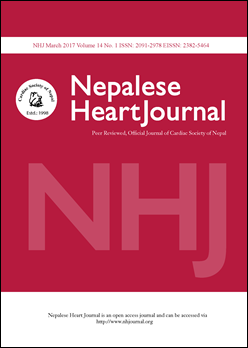Coronary angiography finding of exercise tread mill test positive patients in a tertiary care center
DOI:
https://doi.org/10.3126/njh.v14i1.17190Keywords:
Coronary angiography, Coronary artery disease, Tread mill stress testAbstract
Background and Aims: The use of coronary angiography in diagnosing coronary artery disease is limited by its invasive property. In the other hand correct interpretation of tread mill test data and its use as a key diagnostic modality also has been a problem. The study was thus aimed to see the diagnostic accuracy of treadmill test to rule out coronary artery disease.
Methods: We included all the patients who had positive tread mill stress test and underwent coronary angiography and were subsequently analyzed for presence of coronary artery disease.
Results: A total of 303 patients were included with 119 males and 184 females with mean age of 53.6±10.5 yrs and 51.7±8.6 yrs respectively. Normal coronaries was seen in 114(54.0%), borderline lesion in 29 (13.7%) and significant lesion in 68 (32.2%) with 48(22.7%) having single vessel disease, 29(13.7%) double vessel disease and 14(6.6%) triple vessel disease. Coronary artery diseases was highest among diabetics (57.7%, OR 1.72 (95 % CI: 0.92 to 3.20), p value-0.08).Similarly the risk of coronary artery disease was significantly highest among patient with ≥2 risk factor (OR: 8.10,95 % CI: 4.96 to 13.24, P < 0.0001). Gender distribution showed that coronary artery disease was significantly higher in males than females (53% vs 35% respectively, OR: 2.08, 95 % CI: 1.30 to 3.32, p value-0.002).
Conclusion: The value of tread mill test to predict coronary artery disease is highest in patients with two or more risk factor especially in those with diabetes with significance increased among males.
Downloads
Downloads
Published
How to Cite
Issue
Section
License
This license enables reusers to distribute, remix, adapt, and build upon the material in any medium or format, so long as attribution is given to the creator. The license allows for commercial use.




